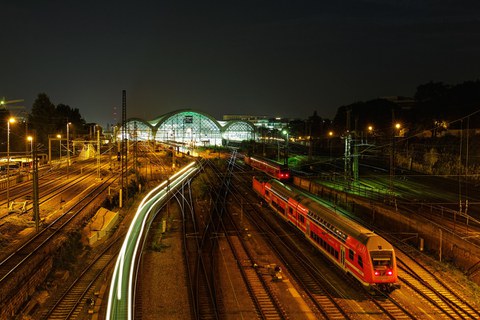Dienstreisen nachhaltig gestalten
Inhaltsverzeichnis

Mit der Bahn umweltfreundlich auf Dienstreisen unterwegs
Dienstreisen erzeugen einen erheblichen Anteil der Umweltbelastungen, die im Rahmen der Aktivitäten einer Hochschule entstehen. Für Hochschulen haben Dienstreisen aber auch einen hohen Stellenwert. Die Vernetzung im Rahmen von Konferenzen und Fachtagungen, der gegenseitige Austausch von Vortragsredner:innen oder das Arbeitstreffen im Rahmen von Forschungsprojekten mit nationalen und internationalen Partner:innen sind substantieller Bestandteil der Aktivitäten von Hochschulen. Während also ansonsten bei Maßnahmen im Verkehrsbereich oft eine Reduzierung der Verkehrsleistungen das klare Ziel ist, stellt sich im Hochschulbereich die Frage, ob die Reduktion der Verkehrsleistung der Beschäftigten ein uneingeschränktes Ziel sein kann, oder ob eine hohe Mobilität der Beschäftigten gerade ein Qualitätsmerkmal einer gut vernetzten Hochschule ist. Natürlich kann die Sinnhaftigkeit einzelner Flugreisen hinterfragt werden, die letztliche Entscheidungshoheit liegt aber bei den jeweiligen Genehmiger:innen („Anordnungsbefugte“ lautet die gesetzliche Bezeichnung). Auch die geltenden Gesetze (hier: SächsRKG) müssen berücksichtigt werden; in diesem Zusammenhang wird speziell auf § 3 Abs. 1 SächsRKG verwiesen, wonach der:die Dienstreisende zur Erstattung von dienstlich veranlassten Auslagen Anspruch auf Reisekostenvergütung hat, soweit die Auslagen und die Dauer der Dienstreise zur Erledigung des Dienstgeschäfts notwendig waren.
Im Fokus der Zielsetzung muss deshalb die Entwicklung eines entsprechenden Bewusstseins bei den Akteur:innen und eine möglichst umweltschonende Abwicklung des unvermeidbaren Verkehrs stehen. Die Wahl des Verkehrsmittels entscheidet wesentlich mit darüber, wie viele THG Emissionen bei einer Dienstreise entstehen. Für unvermeidbare Emissionen gibt es die Option der Kompensation über externe Anbieter. Diese Praxis ist allerdings umstritten und derzeit in Sachsens öffentlichem Dienst nicht möglich, d.h. damit einhergehende Mehrkosten müssten ggf. selbst getragen werden.
Vergleichsrechner für Verkehrsmittel
Verschiedene Institutionen bieten Vergleichsrechner oder Informationen zu mobilitätsbedingten Emissionen an, wie z.B. das Tool ecopassenger oder Informationen des Umweltbundesamtes:
https://ecopassenger.org
Vergleich der durchschnittlichen Emissionen von verschiedenen Verkehrsmitteln (Umweltbundesamt)
Veranstaltungen ressourcen- und klimaschonend organisieren
Zur nachhaltigen Organisation von Veranstaltungen hat das Umweltmanagement der TU Dresden einen Leitfaden Nachhaltige Veranstaltungen zusammengestellt.
